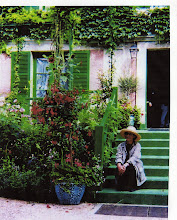
· Based on commonsense approach w/ readily available natural materials
· Saves work, energy, time and money.
· After the initial installation you simply mulch each spring-no tilling or digging required!
· Layers keep garden bed cool and damp, requiring less watering
· Recycles household wastes on site into fertilizer and mulch & keeps it out of the landfills.
- Chemical free, healthy for your family and the environment.
* Planting Basics:
· Soil Test; ask for “organic” recommendations.
· “Charge” existing soil with water, amend to adjust pH if needed
· Smother grass & weeds with thick pads of black & white News Paper or clean Cardboard, making sure to over lap edges by 3-4 inches
· Next add 2-3 inches of peat or pine duff, for paths add wood chips instead.
· Then spread 4-8 inch layer of organic mulch.
· Repeat peat/mulch layers until 18+ inches.
- Each bed will be different depending on your materials.
* “Cooking” the Bed; reduces height & creates a loose, crumbly soil quickly.
· Use 4X as much brown (carbon) material such as peat moss, hay, straw, & chopped leaves, small twigs-as you do green (high-nitrogen) materials such as kitchen scraps, and fresh manure. ** Use a compost thermometer to check that the temperature of the beds reach 150F when using fresh manure.
· Apply material in 4-6 inch layers while at the same time sprinkling organic soil amendments such as wood ash (clean), sea weed (washed), oyster shells (crushed), bone meal, as well as lime or sulfur to adjust pH.
· Be sure to check all the products you purchase have an OMRI (Organic Materials Review) seal on the packaging to be sure it is completely “organic”.
· When the bed is18-24 inches high, cover with a dark material such as plastic, or cover with a thick layer of old straw that is weed seed free.
· With the right amount of sun, moisture and temperature the bed will break down into beautiful soil in 6-8 weeks, with the help of billions of living organisms in the soil.
Lead by Dylan Wallace & Claudia Butler
NOFA Accredited Organic Land Care Professionals
Nantucket Native, specializing in Edible and Medicinal Plants
Contact: nantucketnative@gmail.com
Sources
* LASAGNA GARDENING: A NEW LAYERING SYSTEM FOR BOUNTIFUL GARDENS: NO DIGGING, NO TILLING, NO WEEDING, NO KIDDING! By Patricia Lanza. St. Martin’s Press, 1998.
* OMRI web site has current products lists and publications,http://www.omri.org/.
* NOFA information & handbook, http://www.nofamass.org/pubs/
Container Gardening
If you have a sunny space for a pot on your patio,deck, windowbox, you have room enought to grow summer veggies. For some varieties it is best to choose compact varieties, expect to train vining crops like bean, pea, squash on supports.
Containers: Large - from 18 to 24 inches wide and 12-16 inches deep will keep roots from drying out quickly and give them room to grow. Plastic, terracotta, wood - with drainage holes.
Potting Soil: I use a commercial mix that includes pine bark and is not too fine - there are organic potting soils but I don't have experience with them yet.
Fertilizers: aged chicken manure 3 parts potting soil to one part chicken. I would also add 1/2 cup of bone meal in a 24 inch pot - less for smaller. The liquid organic fertilizers are good - especially if you are noticing deficiencies - yellow leafs, yellow margins on your leafs - I use fish based products and foliar feed as well - spray or pour over leafs - Neptunes Harvest claims it repels deer..

No comments:
Post a Comment